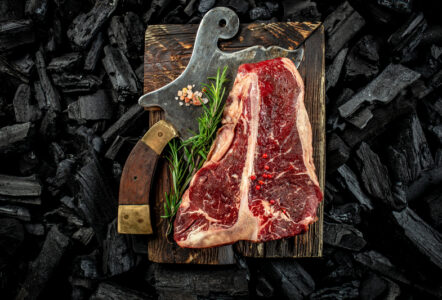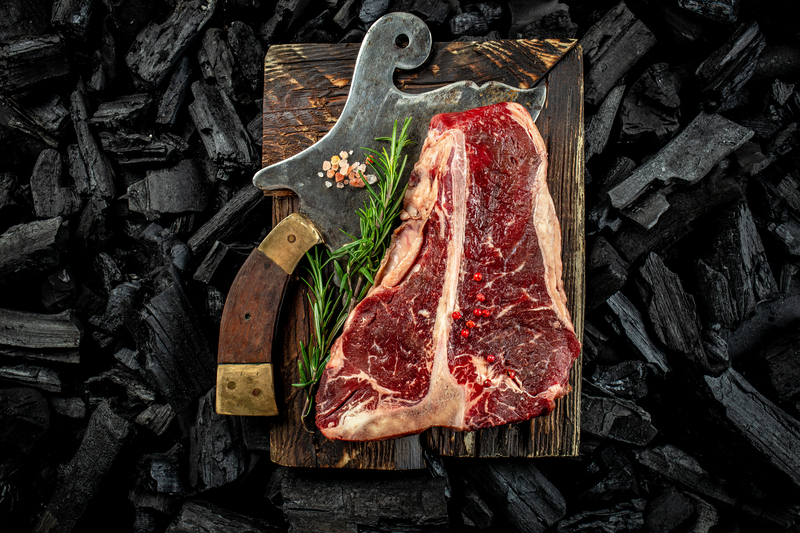 Cooking on a charcoal grill brings a distinct flavor that sets it apart from other grilling methods.
Cooking on a charcoal grill brings a distinct flavor that sets it apart from other grilling methods.
Grilled meats become infused with a smoky taste that enhances their natural flavors.
When it comes to selecting the best meat for a charcoal grill, beef steaks like ribeye or sirloin are often considered top choices.
Ribeye steaks are ideal for charcoal grilling due to their rich marbling and ability to retain juiciness over direct heat.
The versatility of a charcoal grill allows for a wide range of meats to be cooked, each offering unique benefits.
Chicken is another popular option, providing a light, flavorful alternative that crisps up beautifully on the grill.
Pork, particularly ribs or chops, is another excellent choice, as it absorbs the smoky essence well while maintaining tenderness.
Charcoal grilling offers an unparalleled experience for outdoor cooking enthusiasts.
It’s important to highlight the benefits of charcoal grilling, such as its ability to reach higher temperatures compared to gas grills.
This makes it ideal for searing meats to perfection and creating that coveted crust.
Grilling enthusiasts appreciate the enhanced flavor profile that charcoal provides, making it an essential component of any outdoor cooking adventure.
The best meat for the charcoal grill varies with personal preference, but ribeye, chicken, and ribs are consistently top picks due to their flavor and texture.
Choosing the Right Charcoal
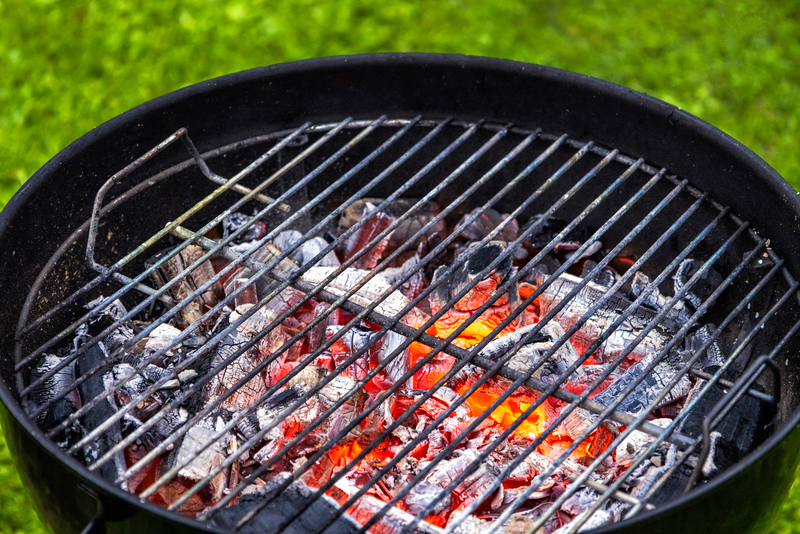
Achieving perfect grilling results involves selecting the right type of charcoal and knowing how to light it efficiently.
The choice between lump charcoal and briquettes impacts flavor and cook time.
Using a chimney starter ensures consistent ignition for optimal grilling.
Lump Charcoal vs Briquettes
Lump charcoal consists of pure, natural wood pieces.
It burns hotter and is favored for its ability to impart a rich, smoky flavor to meat.
Benefits include its minimal chemical additives and its capacity to create high heat swiftly.
Some prefer it for cooking steaks and other fast-searing meats.
Briquettes, on the other hand, offer steady and even heat.
Made from a mix of sawdust, wood scraps, and fillers, they burn longer and provide consistent temperature control.
Their predictable heat makes them ideal for longer cooking sessions, such as slow-cooked ribs or poultry.
Differences:
- Flavor: Lump provides a strong smoky taste, while briquettes are milder.
- Burn Time: Briquettes last longer.
- Heat Control: Briquettes offer steady heat, lump burns hotter.
Starting a Charcoal Grill with a Chimney Starter
 A chimney starter is an efficient way to ignite charcoal without using lighter fluid, which can affect food taste.
A chimney starter is an efficient way to ignite charcoal without using lighter fluid, which can affect food taste.
It features a metal cylinder with air vents for optimal airflow and quick ignition.
Users place crumpled newspaper at the bottom and fill the top with charcoal.
Steps to Use:
- Load the Chimney: Fill the top section with lump charcoal or briquettes.
- Light the Paper: Ignite the newspaper or a specially designed fire starter.
- Wait: Allow the charcoal to light fully until gray ash covers the edges, indicating readiness.
A chimney starter ensures uniform heating, reducing the chance of cold spots.
This method is cleaner and safer, with the added benefit of enhancing the flavor by eliminating lighter fluid residues.
The Best Meats for Charcoal Grilling
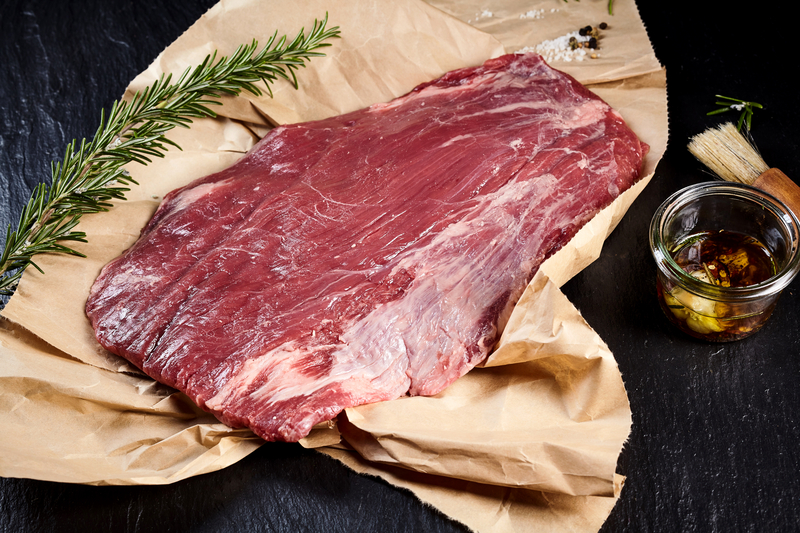
A charcoal grill brings out unique flavors in various meats, enhancing their taste and texture through the smoky aroma.
Knowing which meats work best on a charcoal grill can elevate any outdoor cooking experience, whether it’s juicy steaks or tender poultry.
Steaks: Selection and Preparation
For grilling steaks on charcoal, choosing cuts like ribeye and prime rib offers robust flavors.
These steaks benefit from the high heat, which creates a perfect crust while keeping the inside juicy.
To prepare, season with salt and pepper or a preferred steak rub. S
earing each side for a few minutes directly over the coals, then moving to indirect heat helps achieve desired doneness.
Letting the steak rest post-cooking ensures retained juices and rich flavors.
Poultry: Chicken and Turkey Techniques
Grilling chicken and turkey over charcoal enhances their natural flavors, with smoked turkey being a popular choice.
Chicken thighs and breasts, when marinated adequately, can take on a variety of flavor profiles.
For turkey, brining or marinating helps keep the meat juicy.
Using an indirect grilling method is vital to cook poultry evenly without burning.
Adding wood chips can lend a subtle smokiness, enhancing the overall taste of the meat.
Pork: Ribs and Chops Grilling
Pork ribs and chops respond well to charcoal grilling due to their fat content, which renders well over an open flame.
Baby back ribs benefit from a low-and-slow approach.
Applying a dry rub or marinade enhances flavor.
For pork chops, using a quick sear on direct heat followed by indirect grilling ensures perfectly cooked, juicy meat.
Resting the meat post-grill intensifies the savory flavors.
Adventurous Meats: Lamb Chops and Brisket
Lamb chops and brisket offer unique flavors well-suited for charcoal grilling.
Lamb chops are tender and can be seasoned with herbs, salt, and pepper before grilling them over medium heat for a quick, flavorful meal.
Brisket, known for smoking, requires a longer time on indirect heat.
A spice rub or marinade enhances its deep, rich flavors.
Patience with brisket rewards with tender, flavorful results that highlight charcoal grilling.
Casual Fare: Burgers and Sausages
Ground beef for burgers and a mix of sausages are staples in casual grilling.
Hamburgers made from high-quality ground beef stay juicy and flavorful on a charcoal grill.
For perfectly grilled burgers, ensure they are not pressed too thin, and let them sear on both sides.
Sausages, when grilled, can be pre-cooked to prevent burning.
The direct heat caramelizes the casing while keeping the inside flavorful and juicy.
Grilling Techniques
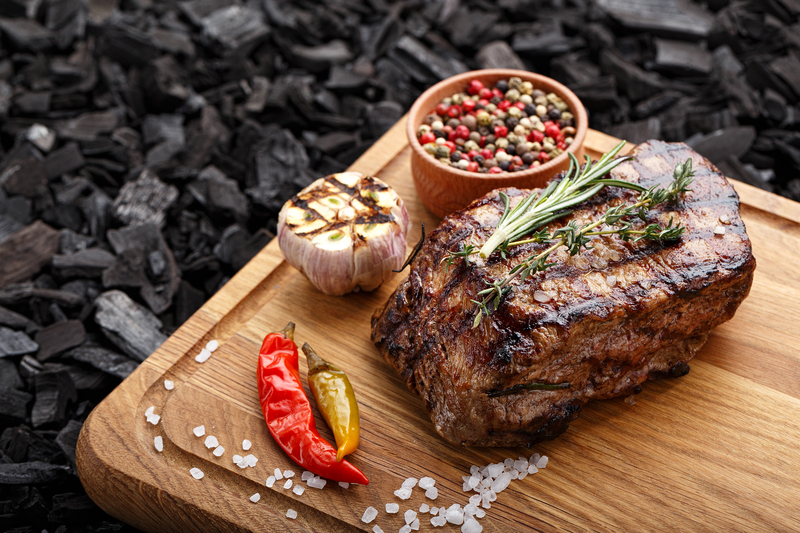
Cooking meat on a charcoal grill requires understanding various heat methods to achieve delicious results.
Direct and indirect grilling are key approaches that help create perfectly cooked meats, such as flank steaks or a whole chicken.
Mastering Direct Heat Grilling
Direct heat grilling means placing meat directly over hot coals.
This method is ideal for thin cuts like steaks, burgers, and chops.
With this technique, the meat sears quickly, locking in juices and creating a flavorful crust.
Flank steak, for example, benefits from being grilled directly for a crisp exterior and juicy interior.
Maintaining consistent, high heat is crucial, as fluctuations can affect the cooking process.
Grilling tips for direct heat include using a two-zone setup to provide a cooler side for moving the meat if flare-ups occur.
Regularly turning the meat helps avoid burning while ensuring even cooking.
A thermometer helps in checking the cooking temperature, ensuring the meat reaches the desired doneness without becoming overcooked.
Perfecting Indirect Heat Grilling
Indirect heat grilling involves placing meat away from the hot coals, allowing it to cook more slowly.
Larger cuts, like a whole chicken or ribs, benefit from this method as it ensures even cooking without burning the exterior.
It’s essential to bank the coals to one side of the grill or use a charcoal basket for an efficient setup.
Positioning a drip pan beneath the meat helps catch juices and prevents flare-ups.
Keeping the grill covered retains heat, acting much like an oven.
A balanced cooking temperature is important, so adjusting vent openings can regulate airflow.
Indirect grilling requires patience, but the result is tender, evenly cooked meats that are worth the wait.
Grilling Larger Cuts of Meat
When tackling larger cuts, such as a chuck roast or pork shoulder, it’s vital to combine indirect heat grilling with longer cooking times.
Pulled pork, a favorite for its tenderness and flavor, benefits from this approach.
These cuts require hours to break down connective tissue, resulting in juicy, tender meat.
Wrap meat with foil during the final stages, which helps retain moisture and enhances flavor.
A meat thermometer ensures the right internal temperature is reached without cutting into the meat prematurely.
Allowing the meat to rest afterward lets the juices redistribute evenly, providing an optimal taste experience.
Seasonings and Marinades
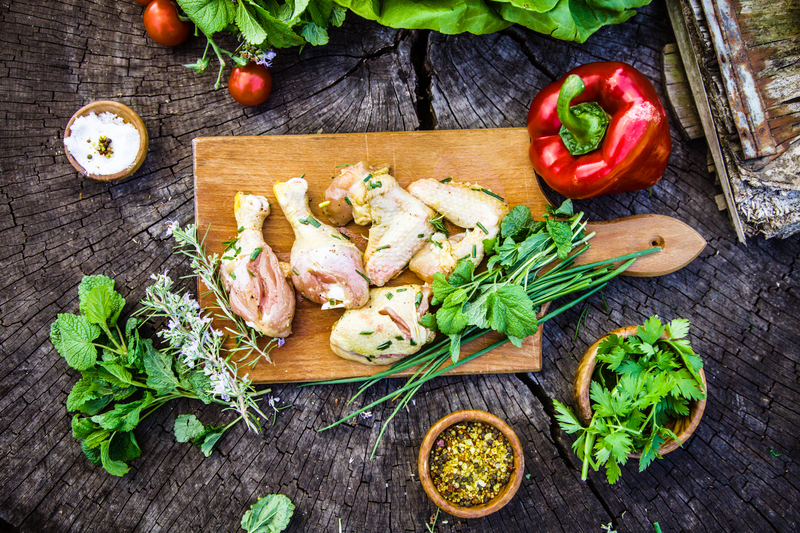
Seasonings and marinades play a crucial role in enhancing the flavor of meat cooked on a charcoal grill.
They add depth and complexity, transforming a simple barbecue into a memorable culinary experience.
From dry rubs to flavorful sauces, each adds its unique twist to the smoky taste imparted by charcoal grilling.
Dry Rubs and Spice Blends
Dry rubs are mixtures of spices and herbs applied directly to the meat.
They create a flavorful crust when grilled.
Common ingredients include paprika, cumin, garlic powder, and brown sugar.
These components bring out an earthy, sweet, and spicy taste.
It’s vital to evenly coat the meat to ensure balanced flavor.
Rubs can also include salt to enhance juiciness by drawing in moisture.
This rub is left on the meat for several hours to intensify the flavors.
With these blends, the natural smoky aroma from the charcoal blends seamlessly with the spices.
Homemade Marinades for Flavor and Tenderness
Marinades involve a liquid mixture to soak meat for a few hours up to overnight.
Ingredients such as soy sauce, vinegar, oil, and herbs are common.
They serve dual functions: infusing the meat with ample seasoning while tenderizing it.
Acidic elements like lemon juice break down connective tissues,
making the meat softer.
Marinades penetrate deeply, ensuring each bite is flavorful.
Aromatics such as garlic and onion bring an added layer of complexity.
They make a significant difference, especially with cuts that benefit from tenderization.
Sauces to Complement the Smoky Taste
Barbecue sauces are often brushed on toward the end of grilling.
These sauces, rich in tomato, molasses, or mustard base, add moisture and enhanced taste profiles.
The sugar content helps caramelize the sauce when heat is applied, creating a delightful sticky glaze.
Varieties include sweet, spicy, or even vinegary options, catering to different taste preferences.
To complement the natural smokiness from the charcoal, choose a sauce that balances rather than overpowers.
Sauces bring everything together, finishing the dish with a hint of zest, sweetness, or spiciness, amplifying the barbecue experience.
Grilling Safety and Maintenance
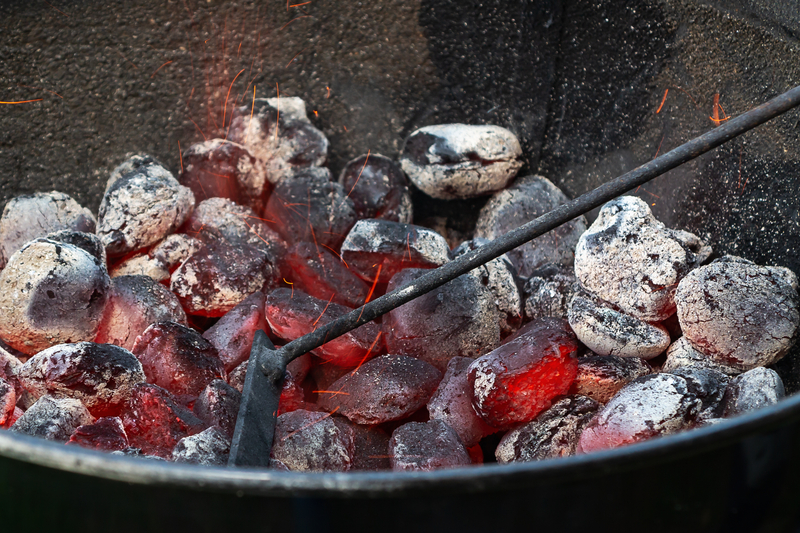
Ensuring the safety and proper maintenance of a charcoal grill is essential for the best grilling experience.
Effective temperature management and routine cleaning not only keep food safe but also extend the lifespan of the grill.
Managing Grill Temperatures and Safety
Controlling the temperature on a charcoal grill requires monitoring and adjustments.
Start by using a meat thermometer to verify the cooking temperature.
This ensures meat is cooked thoroughly, reaching safe temperatures to prevent foodborne illnesses.
Different meats require specific internal temperatures,
for example, chicken should reach 165°F.
Keep a close eye on the grill, using vents to manage the airflow and maintain control over the heat.
Never leave a lit grill unattended.
Water spray bottles can help contain flare-ups by quickly reducing excessive flames.
Cleaning and Maintenance of the Charcoal Grill
Regular cleaning maintains the grill’s performance and flavor quality.
To clean, let the grill cool down after cooking, then remove the grates.
Use a wire brush to scrub away residue, preventing buildup that could impact future cooking.
Inspect the grill for any signs of rust or damage.
Check the ash catcher, ensuring it is clear of buildup to maintain airflow for the next grilling session.
Performing consistent maintenance ensures a safe and enjoyable experience each time the grill is used.
Serving and Presentation
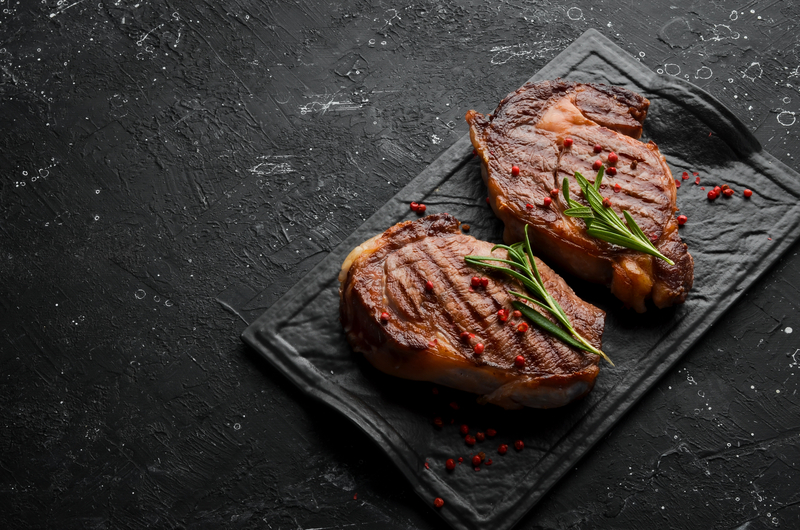
When serving grilled meats from a charcoal grill, it’s important to highlight the rich, smoky flavor that the grill imparts.
Use a wooden board to present your selection, which can enhance the rustic appeal of the meal.
Arrange meats neatly, allowing for an enticing view of the beautifully charred grill marks.
For tender chicken, slice it into thin, manageable pieces.
This not only makes it easier for guests to serve themselves but also allows them to appreciate the tenderness achieved through the cooking process.
The slight char on the edges hints at perfectly grilled chicken and should not be overlooked.
Adding a garnish is a simple yet effective method to elevate the presentation.
Fresh herbs like parsley or cilantro can provide a pop of color.
A few lemon wedges on the side add both visual contrast and the opportunity to enhance flavor with a citrus note.
Finally, consider providing small bowls of sauces or dips alongside your grilled meats.
Barbecue sauce or even a spicy yogurt dip can be great complements to the natural flavors of the grilled meats.
Arrange these around the board for easy access and visual balance.

